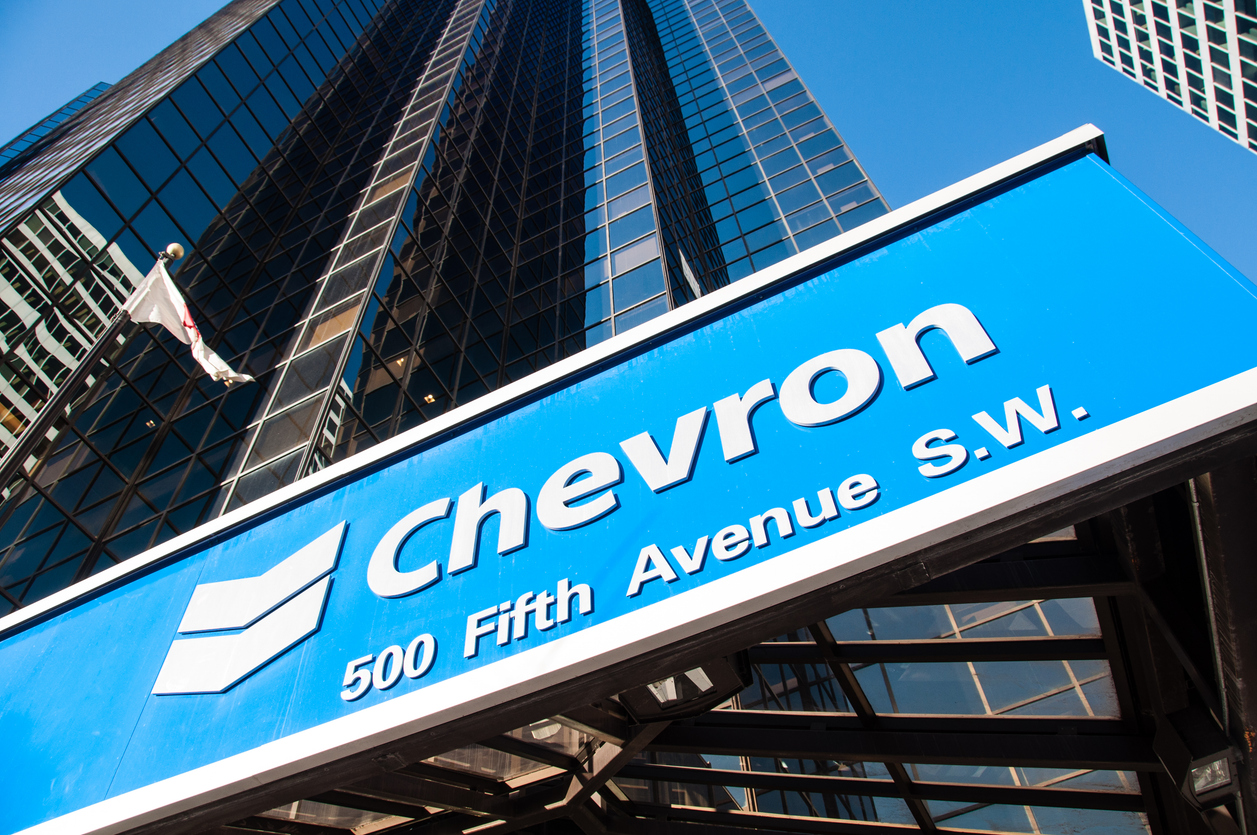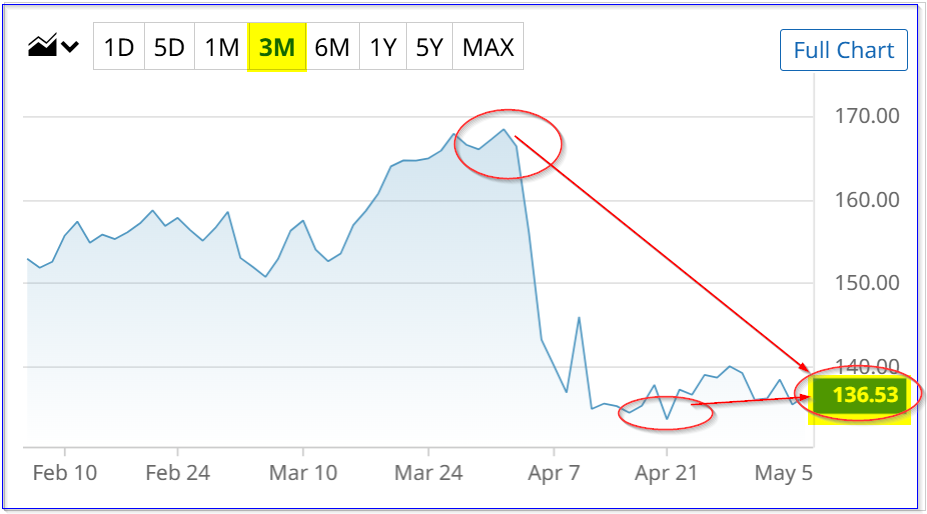- Market Overview
- Futures
- Options
- Custom Charts
- Spread Charts
- Market Heat Maps
- Historical Data
- Stocks
- Real-Time Markets
- Site Register
- Mobile Website
- Trading Calendar
- Futures 101
- Commodity Symbols
- Real-Time Quotes
- CME Resource Center
- Farmer's Almanac
- USDA Reports
Chevron's Free Cash Flow Doesn't Cover Its Dividends and Buybacks - Is CVX a Buy Here?

Chevron Corp (CVX) reported mediocre Q1 results on Friday, May 2. The company had to increase its debt to cover shareholder payments, as its free cash flow wasn't strong enough. CVX stock has been waffling, staying near its lows.
So, should investors buy CVX stock here? One play is to sell short puts for income and to set a potential lower buy-in target price.
CVX is up today in midday trading at $136.20 per share. This is still well off its high of $168.51 on April 1, but close to a low of $134.54 on April 15.

Free Cash Flow vs. Dividends and Buybacks
Oil and gas prices have been weak. As a result, Chevron's Q1 cash flow from operations (CFFO) has faltered. It was down to $5.2 billion in Q1, down over 40% from Q4 when it was $8.7 billion.
Moreover, its free cash flow (i.e., after slightly lower capex spending) fell to just $1.3 billion in Q1 compared to $4.4 billion in the prior quarter. However, Chevron likes to exclude a significant component of CFFO and FCF - changes in working capital (WC). This can be volatile from quarter to quarter.
So, after excluding net WC changes, its FCF rose from $1.0 billion in Q4 to $3.7 billion. But that is still lower than last year, as can be seen in the table below.

However, this FCF (without including W/C) still does not cover the company's dividend and buyback payments for shareholders. This can be seen on page 6 of Chevron's investor presentation deck:

It shows that dividends and buybacks cost Chevron $6.9 billion in Q1, vs. $3.7 billion in FCF ex W/C changes. And remember, from the table above, the actual free cash flow after W/C flows was just $1.3 billion.
So, no wonder Chevron had to borrow $5.0 billion. That was needed to cover all its payments, even after its inflows from cash from operations.
If oil and gas prices don't improve, Chevron is either going to have to eventually sell more assets or cut back on its buybacks. In any case, the dividend looks secure here. It only costs $3.0 billion a quarter, easily financed by free cash flow (ex W/C.
So, does that make CVX stock a buy or hold?
Dividend-Based Price Targets
I discussed a dividend-based price target for CVX stock in an April 21 Barchart article ("Is Chevron Stock Too Cheap With Its 5.1% Yield After Its Recent Dividend Hike?).
At the time, CVX stock was at $133.28, and I showed that based on its historical dividend yield, CVX could be worth $154.66. For example, Morningstar reports that the average dividend yield over the last 5 years has been 4.19%.
So, taking the $6.84 dividend per share (DPS) and increasing it to $6.93 (i.e., with one quarterly payment that is 5% higher), and dividing it by 4.87%:
$6.93 DPS / 0.0419 = $165.39
Over the trailing 12-month (TTM) period, the average yield has been 4.87%. So, that implies the price target would be $142.30:
$6.93 / 4.87% = $142.30
The average of these two price targets is $153.85 per share, or +12.7% higher.
Analysts tend to agree. For example, Yahoo! Finance reports that the average of 23 analysts is $165.45, or +21.5% higher than today's price. Moreover, Barchart's mean survey price is $169.00.
Similarly, AnaChart.com shows that 22 analysts have a price target of $169.02 on average. The bottom line is that these price targets, either from a dividend-based approach, or the average of analysts, are significantly higher.
But there is no guarantee CVX will rise. One way to play this is to short out-of-the-money (OTM) put options. That way, investors can get paid while waiting to potentially buy the stock at a lower exercise (strike) price in near-term expiry periods.
Shorting OTM Puts
I discussed this in the April 21 Barchart article, recommending shorting the $130.00 strike price put option for the May 23 expiration period.
At the time, the midpoint premium received for doing this play was $4.78 per put contract (giving them an immediate yield of 3.68%). Today, it's down to $1.42, giving the short seller a good profit (i.e., they can buy back or cover the short sale and make a $3.36 gain per contract shorted).
New investors (or those wishing to roll over the May 23 short sale) can make a higher yield by shorting $130 strike price puts in the June 6 expiry period.
The table below shows that the midpoint price is $2.32. That gives investors an immediate yield of 1.785% (i.e., $2.32/$130) over the next month.

This is one way an investor can set a potentially lower buy-in price and still get paid while waiting to see if this happens. The breakeven price, if CVX falls to $130 on or before June 6, is $130-$2.32, or $127.68. That is about 6% lower than today's price.
More risk-averse investors can enter an order to “Sell to Open” puts at the $125.00 strike price. The immediate yield is lower - $1.27/$125.00 or just over 1.0% (1.016%). But the break-even price is 8.9% below today's price at $123.73.
There is always the risk that this could result in an unrealized capital loss. - This could occur if CVX falls below these breakeven points. The investor's account would be assigned to buy shares (from collateral required at the beginning of the trade) from these short-sale put plays. Investors can study the downside risks by going to Barchart's Options Learn Center, such as the Options Trading Risk tab.
The bottom line is that CVX stock looks cheap here, despite lower free cash flow results. The risk is that if oil and gas prices continue to decline, its cash flow could falter. In that case, Chevron may have to slow its buybacks and/or take on more debt. This could be why CVX stock is still near its lows here.
One way to play it, setting a lower buy-in target price, is to short out-of-the-money puts in nearby expiry periods. So far, that trade seems to be working for value investors.
On the date of publication, Mark R. Hake, CFA did not have (either directly or indirectly) positions in any of the securities mentioned in this article. All information and data in this article is solely for informational purposes. For more information please view the Barchart Disclosure Policy here.